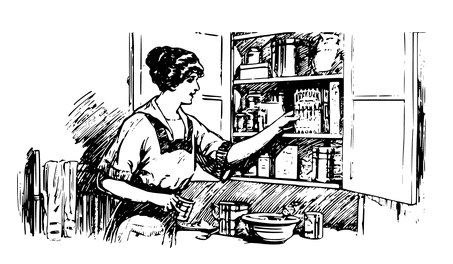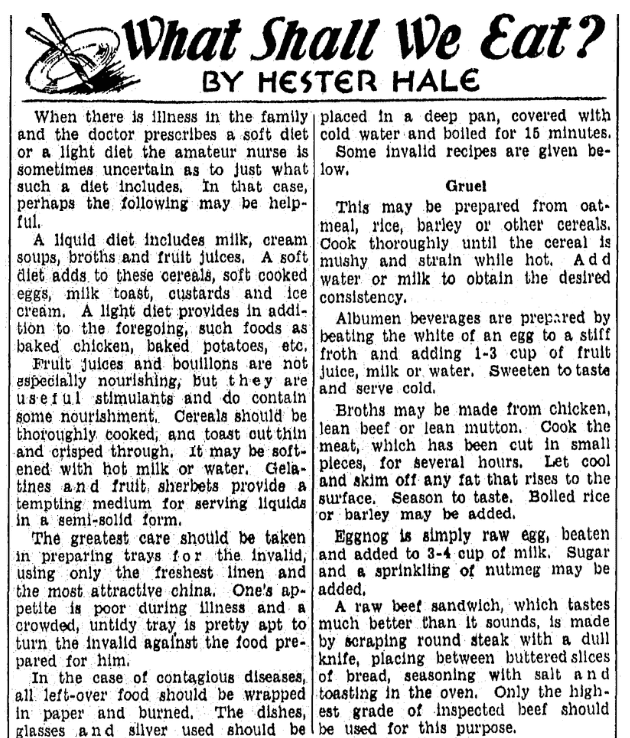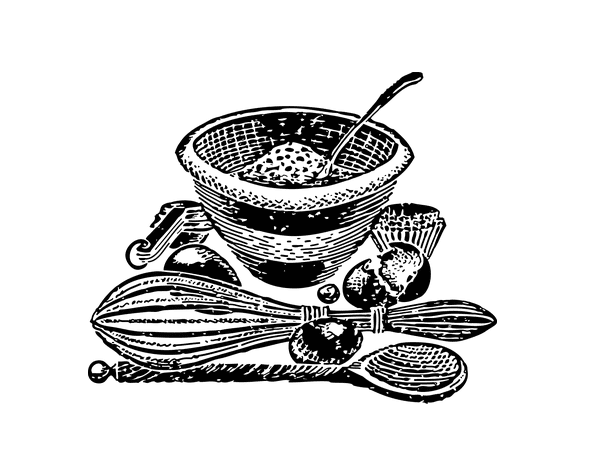Introduction: In this article, Gena Philibert-Ortega searches old cookbooks and newspapers to find recipes for what our ancestors ate when they were sick. Gena is a genealogist and author of the book “From the Family Kitchen.”
One thing we all have in common is that we eat differently when we are sick. Being sick, no matter how minor the cold, requires a different diet than our normal fare. When I asked my Facebook friends what they were fed as sick children, overwhelmingly the answer was chicken noodle soup or broth. But there were also answers that ranged from beverages like Ginger Ale or hot tea to foods like milk toast and crackers.
Not surprisingly, cooking for those who are sick has changed over time. What your grandmother or great-grandmother served her family is likely not the same as what your sick family members eat today. Historical cookbooks and old newspapers, such as GenealogyBank’s Historical Newspaper Archives, provide us with a look at the evolution of feeding the sick.

As I perused old cookbooks and home economics texts in my collection, one thing was clear: historically there were different types of invalid diets, and the type of illness determined what was served. The same is true today. You wouldn’t serve the same thing to someone who is recovering from surgery as you would a person getting over a cold.
In a 1917 manual titled Elements of the Theory and Practice of Cookery, it is noted that there are three kinds of diets for the sick, classified as liquid, light, and convalescent. A liquid diet is made up of the obvious, liquids – but in 1917 that means unfamiliar drinks such as beef-tea and beef-juice, as well as the familiar hot milk to help a person get some rest. A light diet is for the patient who is starting to improve and is made of liquids and eggs, soup, gelatin, puddings and “tender meat.” Finally, a convalescent diet includes all ordinary dishes except those particularly difficult to digest.*
It appears that “invalid recipes” stay pretty consistent from the late 1800s to the early 1900s. The 1936 newspaper column “What Shall We Eat” answers the question of what to feed the invalid, with recipes for egg nog, gruel, and a raw beef sandwich, suggestions I saw in other texts as well. My favorite part of this newspaper article is the description of the raw beef sandwich:
“A raw beef sandwich, which tastes much better than it sounds, is made by scraping round steak with a dull knife, placing between buttered slices of bread, seasoning with salt and toasting in the oven.”

Beverages
One of the beverages that I found repeatedly for the sick was beef tea. Similar to beef broth, recipes for this beverage can be found in historical newspapers.
This particular newspaper article also includes a recipe for rice water which is exactly what it sounds like. You can add sugar or salt to the water when finished cooking the rice to provide some additional flavor to the liquid.
If you have access to grape juice, there are quite a few recipes to feed the sick in 1919. This newspaper article includes recipes for grape frappe, grape ice cream, and grape whip. All guaranteed to satisfy the invalid’s sweet tooth since they not only contain grapes but plenty of sugar.
If you’re a big fan of grapes, you might want to read the entire article. The recipes aren’t just for the traditional juice drinks and jelly. There’s even a recipe for grape catsup!
Foods
One of the issues with eating when you are ill or recovering from surgery is that you may not feel like eating. Depending on the illness, you may feel like you can’t stomach much in the way of food. This newspaper article points out that the invalid food of 1940 is different than the foods served by the reader’s grandmothers:
“Canned pureed foods, canned soups and bouillon cubes are all benefits in invalid cookery that were not available to our grandmothers. These products reduce the length of time necessary to produce special dishes.”
The recipes provided in the article are “old-fashioned recipes” to keep “on file in case of emergency.” The 1940 mom did have more choices in feeding sick family members, including the recently introduced version of Campbell’s chicken noodle soup (1934).
These 1940 recipe ideas include egg nog, beef tea, and onion gruel. I can definitely affirm that the onion gruel is probably not something I’d request when sick or even when I’m well. Made with onions and milk, it’s basically a cream of onion soup. It’s suggested that you can flavor the gruel with some beef extract.
One food mentioned by my friends that has a longer history as an invalid food than canned soup is milk toast. This 1904 recipe is the “time-honored recipe handed down from our grandmothers.” In this recipe the toast is browned and buttered which is then “bathed” in the “milk” sauce which includes milk, flour, butter, and salt.
In case you want multiple ideas for milk toast to make it appetizing, this 1929 newspaper article states:
“Milk toast can be, perhaps, the most delightful of toasts when properly made, but too many people remember sad, soggy specimens served to them when either extreme youth or illness made it impossible for them to run away.”
The toast featured in this article ranges from the sweet to the savory and includes different takes on milk toast – including one that has cayenne pepper on it.
What Comfort Food Do You Eat when Sick?
Growing up, I ate mostly chicken noodle soup and Jello when I was sick. I feed my kids basically the same thing – except there are times when we’ve been known to eat spicy foods in an effort to clear up stuffed noses. What did you eat when you were sick? Has that changed now that you’re an adult? What food memories are part of your family history? Please tell us in the comments section below.
Explore over 330 years of newspapers and historical records in GenealogyBank. Discover your family story! Start a 7-Day Free Trial
* Williams, Mary E and Katharine Rolston Fisher, Elements of the Theory and Practice of Cookery. New York: Macmillan Company, 1917. P. 327-328.
